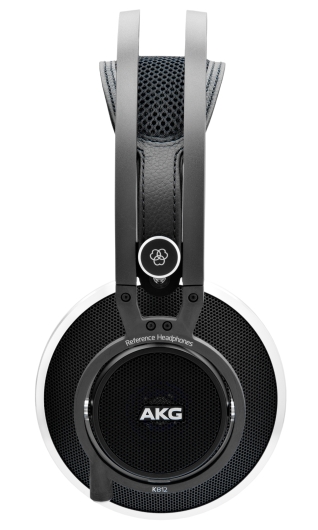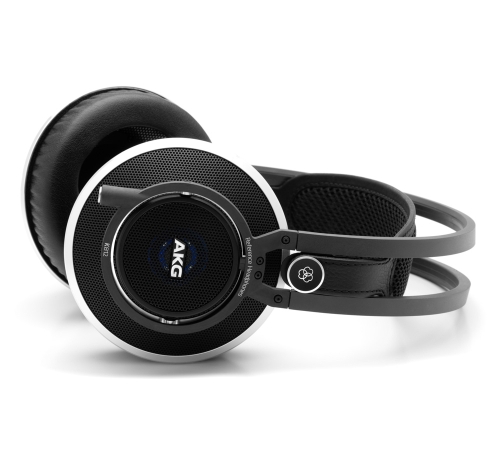AKG has been making quality electronics since 1947. Located in Austria, the company has a rich tradition since being founded by Dr Rudolph Goeirke and Ernst Pass, their first headphones having been designed in 1949. In 1984 they became a publicly owned company and merged with Harman International in 1994. Harman pretty much lets AKG run as a separate company designing and building their own products, many of which are still manufactured in Austria.
My first experience with AKG started in 2008 when I purchased the AKG K701. The headphone had a cult following and was highly regarded in audio circles as being a reference grade headphone. Many people including studio professionals liked them for their honesty. The biggest drawback for many who used them was that the sound signature could be bright and they were light in bass reproduction. Other users felt that they were too analytical and cold, providing more of a sterile sound while many others felt they were hard to listen too for extended listening sessions.
They remained the affordable reference headphone for a number of years, The K701 was tinkered with and many adjustments made to them over the years, but none ever addressed the bass issue. The company seemed entrenched in the mid-fi market and many new designs surpassed the AKG 701, many enthusiasts ignoring them for the newer more exciting designs that emerged in personal and professional audio.
Design
The K812, designed by AKG, is different from prior designs. According to AKG, the Tesla 1.5 driver provides the most accurate and powerful experience possible for the listener. At 53MM in size, it has a two-layer voice coil and is one of the largest drivers currently in production in the industry. The pads used are pleather and the termination to the cable is single ended with a 3.5MM plug which comes with a ¼ inch screw in adapter. The cord is not removable and is internally wired through the headphone.

Included in the packaging is a first class wood stand and an attractive box for storage. The weight of the K812 as listed as a little over 13 ounces (370 grams). Rated at 36 Ohms with a frequency response of 5HZ-110 db. The headphone is manufactured in Austria.
Listening
Most people who read my reviews know that what is important to me in headphone design is the tonality. How accurate does an instrument sound? Is the sound that I hear close to the instrument that I hear live? Does it have the proper detail that makes listening more enjoyable? How well does it present the soundstage? Can I close my eyes and wrap myself into the stage? Can I picture clearly where each performer is within that stage and is there space and air? These are the normal things that run through my mind while auditioning new headphones.
Answering these questions was easy with my listening sessions with the K812. The K812 has a wide and deep soundstage. The performers are all layered in the stage with exceptional air and separation. Listening to classical recordings is very special on the K812. The layering of different sections is also exceptional. The space between the musicians and layering of each section left me with a clear picture of the orchestra.
The midrange came to life with Andrea Bocelli’s “Cinema” Bocelli was not recessed in the sound stage and more upfront with the orchestra layered behind him in a 3D soundstage. His vocal was as good as I have heard it reproduced on any dynamic headphone regardless of price.
Bocelli’s memorable performance of “La chanson de Lara” painted a vivid image in my head and with my eyes closed it took me back in time to the classic move “Dr. Zhivago” It brought back memories when Zhivago fell in love with the beautiful Lara. The tonality and pure power of Bocelli’s performance was exciting. The K812 with the Cavalli Liquid Gold out of the single ended jack had incredible synergy and never disappointed. The sound was transparent and liquid, delivering lifelike performances on well-recorded material. Never feeling cheated or disappointed with the pairing made the listening sessions more enjoyable and lasted long hours without fatigue.
Streisand’s album “Back to Brooklyn” took me to the Barclay Center for that magical performance. “As if We Never Said Goodbye” had me totally involved with Bab’s performance. Her upfront vocal was crystal clear. The orchestra was layered and musicians were located in their proper space and the recording was both convincing and dynamic. You could here every syllable coming from her vocal without sibilance and her performance was spectacular. She took hold of me and made me feel as if I were in the hall and she never let go until the music stopped. The entire album brought me to my hometown and felt as if I were there. The K812 delivered all the transparency and dynamic sound with finesse and the speed necessary to make the performance come alive .
The imaging on the K812 is one of its many strong points. The soundstage was 3D in all the recordings used for this audition. The sound stage was wide and deep and had exceptional layering. The individual sections of the orchestra were vivid with my eyes closed and I could feel as if I was there listening to the concert. The deep and extended bass on the K812 is a major improvement over previous AKG designs, textured with excellent detail retrieval.

Daft Punk’s “Get Lucky” has astonishing bass. The definition and extension was all there and nothing missing with the K812, causing my toes to start tapping when the song started. The K812 bass in addition to be textured had good impact and extension. I never felt as if anything was missing with the bass or me wanting more of it. Listening to “Companion”, a live recording by Patricia Barber at Chicago’s Green Mill, the K812 lets you hear both bass and treble extension. Barber’s Hammond Organ on lesser or problematic gear really will let you know how good or bad the treble is, where many lesser headphones will make the sound harsh and piercing while trying to reproduce it.
The K812 delivered the sound if the Hammond Organ without any harshness and always made it sound lifelike. Listening to “The Beat Goes On” the opening track I could hear the Hammond in the upper registers clearly and never piercing. The Organ had texture and you could hear the notes clearly with definition and with exceptional detail. The sound coming from this recording was extended, defined but never harsh or torturous. The K812 delivered made you feel like you were in the venue and was a terrific session. It gave me the feeling I experience in live performances. Likewise, Michael Arnopol’s acoustic bass on “Use Me “ was special with the K812. I could hear each bass note clearly and I could hear the inner detail of his hand moving up and down plucking the strings. Barber’s voice comes in and the bass never overpowered her vocals, once again the K812 delivering excellent bass with definition and terrific extension.
The percussion and tambourines coming from the rear stage were clear and lifelike, the instrumentation or performers never smeared. Percussion on the left side was clear and the Hammond and Barber were centered in the performance. The K812 was imaging with what felt like a 3D soundstage, but more importantly they had me totally involved with the performance having me listening late into the night, not wanting to stop. The neutrality and speed of the K812 was all there and nothing was missing. The hours melted away and the music always sounded fantastic and the K812 sonically always delivered the music.
Final Thoughts
AKG has been making headphones in Austria for a long time. There past designs were always excellent value for the money. The K812 priced at $1499 is more expensive than prior AKG models. The sound coming from the K812 is special and is as good as many other flagship designs and also outperformed some that cost significantly more than the K812. The K812 designed in Austria is one the most exciting designs from AKG and never disappointed in any area and always delivered exceptional musicality.
Vocal performances were stellar. Sibilant free performances are special and the K812 never was sibilant with the recordings used. Whether I was listening to large-scale classical recording or small jazz venues recordings, the K812 was always neutral and live sounding. The sound is balanced throughout the sound spectrum and the music never sounded artificial.Bass sounded so right and the midrange is among the best I have heard and treble reproduction is special. AKG really nailed it with the K812. This is one of the best headphones I heard in 2015.
So what wrong with the K812 many will ask. The drawbacks mostly are minor for me. The cable AKG uses is non removable but does come with a removable 1/4 inch jack making it easy to use with a portable player except the cord is too long for using it portably. The second drawback is the pads. Most headphones I been listening too in this price range have either sheepskin or leather pads. The pads chosen are skimpy pleather but they do work well. The pads do not affect performance, but in a reference headphone in this price range you expect to see real leather or sheepskin pads.
AKG brilliantly designed The K812. The K812 is one of my favorite headphones to use and is comfortable to wear for extended listening sessions. The soundstage is among the best of any headphone currently in production and always delivers everything I look for in a reference headphone. Designed and built for serious music lovers, the K812 never made me feel as if anything was missing from the performance and gets my highest recommendation. Just buy it!
Manufacture Comments
The frequency response is 5Hz to 54kHz and the sensitivity is 110dB
The production currently moving to Slovakia were we have a very good production partner who work to our quality standards.
The reason for the ear pads (just to give you the background (and I totally get your comment): If you use real leather you need to maintain them (clean and wax them with leather-care). We know that our professionals won’t do that and the pads will suffer. So this was an well thought thru decision.
Phillipp Schuster
Product Manager















Reply
Reply
Reply
Reply
Want to join discussion?
Feel free to contribute!